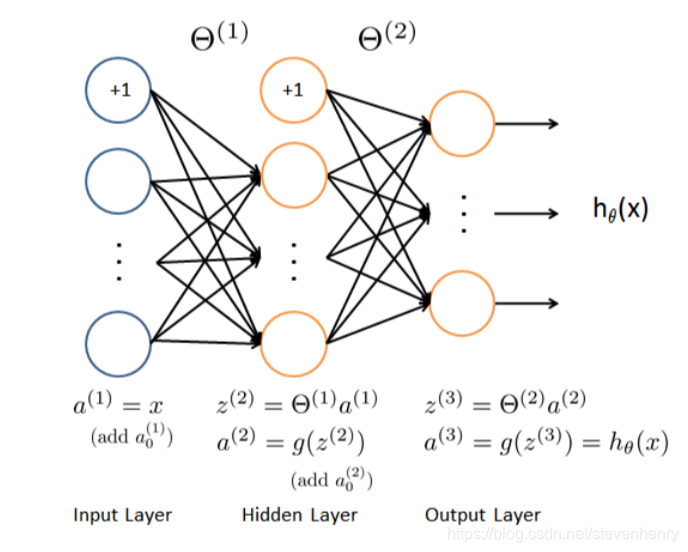Neural Networks
在这个练习中,将实现神经网络BP算法,练习的内容是手写数字识别。
Visualizing the data
这次数据还是5000个样本,每个样本是一张20*20的灰度图片
fig, ax_array = plt.subplots(nrows=10, ncols=10, figsize=(6, 4))
for row in range(10):
for column in range(10):
ax_array[row, column].matshow(sample_images[10 * row + column].reshape((20, 20)).T, cmap='gray')
ax_array[row, column].axis('off')
plt.show()
return
data = loadmat("ex4data1.mat")
X = data['X']
y = data['y']
m = X.shape[0]
rand_sample_num = np.random.permutation(m)
sample_images = X[rand_sample_num[0:100], :]
display_data(sample_images)
Model representation
这是一个简单的神经网络,输入层、隐藏层、输出,样本图片是20*20,所以输入层是400个单元,(再加上一个额外偏差单元),第二层隐藏层是25个单元, 输出层是10个单元。从上面的数据显示中有两个变量X 和y。
ex4weights.mat 中提供了训练好的网络参数theta1, theta2,
theta1 has size 25 x 401
theta2 has size 10 x 26

Feedforward and cost function
为了最后的输出,我们将标签值也就是数字从0到9, 转化为one-hot 码
from sklearn.preprocessing import OneHotEncoder
def to_one_hot(y):
encoder = OneHotEncoder(sparse=False) # return a array instead of matrix
y_onehot = encoder.fit_transform(y.reshape(-1,1))
return y_onehot
加载数据
X, label_y = load_mat('ex4data1.mat')
X = np.insert(X, 0, 1, axis=1)
y = to_one_hot(label_y)
load weight
def load_weight(path):
data = loadmat(path)
return data['Theta1'], data['Theta2']
t1, t2 = load_weight('ex4weights.mat')
theta 转化
因为opt.minimize传参问题,我们这里对theta进行平坦化
# 展开
def unrool(var1, var2):
return np.r_[var1.flatten(), var2.flatten()]
# 分开矩阵化
def rool(array):
return array[:25*401].reshape(25, 401), array[25*401:].reshape(10, 26)
Feedforward Regularized cost function
这里主要是前馈传播 和 代价函数的一些逻辑,正则化为了预防高方差问题。
def sigmoid(z):
return 1 / (1 + np.exp(-z))
#前馈传播
def feed_forward(theta, X):
theta1, theta2 = rool(theta)
a1 = X
z2 = a1.dot(theta1.T)
a2 = np.insert(sigmoid(z2), 0, 1, axis=1)
z3 = a2.dot(theta2.T)
a3 = sigmoid(z3)
return a1, z2, a2, z3, a3
# a1, z2, a2, z3, h = feed_forward(t1, t2, X)
def cost(theta, X, y):
a1, z2, a2, z3, h = feed_forward(theta, X)
J = -y * np.log(h) - (1-y) * np.log(1 - h)
return J
# Implement Regularization
def regularized_cost(theta, X, y, l=1):
theta1, theta2 = rool(theta)
temp_theta1 = theta1[:, 1:]
temp_theta2 = theta2[:, 1:]
reg = temp_theta1.flatten().T.dot(temp_theta1.flatten()) + temp_theta2.flatten().T.dot(temp_theta2.flatten())
regularized_theta = l / (2 * len(X)) * reg
return regularized_theta + cost(theta, X, y)
Backprogation
反向传播算法,是机器学习比较难推理的算法了, 也是最重要的算法,为了得到最优的theta值, 通过进行反向传播,来不断跟新theta值, 当然还有一些超参数,如lambda、a 、训练迭代次数,如果进行adam、Rmsprop等优化学习效率算法,还有有一些其他的超参数。
# random initalization
# 梯度
def gradient(theta, X, y):
theta1, theta2 = rool(theta)
a1, z2, a2, z3, h = feed_forward(theta, X)
d3 = h - y
d2 = d3.dot(theta2[:, 1:]) * sigmoid_gradient(z2)
D2 = d3.T.dot(a2)
D1 = d2.T.dot(a1)
D = (1 / len(X)) * unrool(D1, D2)
return D
Sigmoid gradient
也就是对sigmoid 函数求导
def sigmoid_gradient(z):
return sigmoid(z) * (1 - sigmoid(z))
Random initialization
初始化参数,我们一般使用随机初始化np.random.randn(-2,2),生成高斯分布,再乘以一个小的数,这样把它初始化为很小的随机数,
这样直观地看就相当于把训练放在了逻辑回归的直线部分进行开始,初始化参数还可以尽量避免梯度消失和梯度爆炸的问题。
def random_init(size):
return np.random.randn(-2, 2, size) * 0.01
Backporpagation
Regularized Neural Networks
正则化神经网络
def regularized_gradient(theta, X, y, l=1):
a1, z2, a2, z3, h = feed_forward(theta, X)
D1, D2 = rool(gradient(theta, X, y))
t1[:, 0] = 0
t2[:, 0] = 0
reg_D1 = D1 + (l / len(X)) * t1
reg_D2 = D2 + (l / len(X)) * t2
return unrool(reg_D1, reg_D2)
Learning parameters using fmincg
调优参数
def nn_training(X, y):
init_theta = random_init(10285) # 25*401 + 10*26
res = opt.minimize(fun=regularized_cost,
x0=init_theta,
args=(X, y, 1),
method='TNC',
jac=regularized_gradient,
options={'maxiter': 400})
return res
res = nn_training(X, y)
准确率
def accuracy(theta, X, y):
_, _, _, _, h = feed_forward(res.x, X)
y_pred = np.argmax(h, axis=1) + 1
print(classification_report(y, y_pred))
accuracy(res.x, X, label_y)
Visualizing the hidden layer
隐藏层显示跟输入层显示差不多
def plot_hidden(theta):
t1, _ = rool(theta)
t1 = t1[:, 1:]
fig, ax_array = plt.subplots(5, 5, sharex=True, sharey=True, figsize=(6, 6))
for r in range(5):
for c in range(5):
ax_array[r, c].matshow(t1[r * 5 + c].reshape(20, 20), cmap='gray_r')
plt.xticks([])
plt.yticks([])
plt.show()
plot_hidden(res.x)
super parameter lambda update
神经网络是非常强大的模型,可以形成高度复杂的决策边界。如果没有正则化,神经网络就有可能“过度拟合”一个训练集,从而使它在训练集上获得接近100%的准确性,但在以前没有见过的新例子上则不会。你可以设置较小的正则化λ值和MaxIter参数高的迭代次数为自己看到这个结果。





















 181
181











 被折叠的 条评论
为什么被折叠?
被折叠的 条评论
为什么被折叠?








